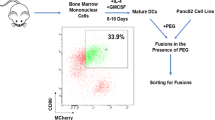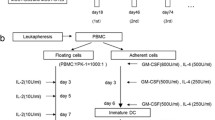Abstract
Pancreatic cancer is an extremely aggressive malignancy with a dismal prognosis. Cancer patients and tumor-bearing mice have multiple immunoregulatory subsets including regulatory T cells (Tregs) and myeloid-derived suppressor cells (MDSC) that may limit the effectiveness of anti-tumor immunotherapies for pancreatic cancer. It is possible that modulating these subsets will enhance anti-tumor immunity. The goal of this study was to explore depletion of immunoregulatory cells to enhance dendritic cell (DC)-based cancer immunotherapy in a murine model of pancreatic cancer. Flow cytometry results showed an increase in both Tregs and MDSC in untreated pancreatic cancer–bearing mice compared with control. Elimination of Tregs alone or in combination with DC-based vaccination had no effect on pancreatic tumor growth or survival. Gemcitabine (Gem) is a chemotherapeutic drug routinely used for the treatment for pancreatic cancer patients. Treatment with Gem led to a significant decrease in MDSC percentages in the spleens of tumor-bearing mice, but did not enhance overall survival. However, combination therapy with DC vaccination followed by Gem treatment led to a significant delay in tumor growth and improved survival in pancreatic cancer–bearing mice. Increased MDSC were measured in the peripheral blood of patients with pancreatic cancer. Treatment with Gem also led to a decrease of this population in pancreatic cancer patients, suggesting that combination therapy with DC-based cancer vaccination and Gem may lead to improved treatments for patients with pancreatic cancer.






Similar content being viewed by others
References
Parkin DM, Bray F, Ferlay J, Pisani P (2001) Estimating the world cancer burden: Globocan 2000. Int J Cancer 94:153–156
Henne-Bruns D, Vogel I, Luttges J, Kloppel G, Kremer B (1998) Ductal adenocarcinoma of the pancreas head: survival after regional versus extended lymphadenectomy. Hepatogastroenterology 45:855–866
Johnson CD, Schwall G, Flechtenmacher J, Trede M (1993) Resection for adenocarcinoma of the body and tail of the pancreas. Br J Surg 80:1177–1179
Mukaiya M, Hirata K, Satoh T, Kimura M, Yamashiro K et al (1998) Lack of survival benefit of extended lymph node dissection for ductal adenocarcinoma of the head of the pancreas: retrospective multi-institutional analysis in Japan. World J Surg 22:248–252 discussion 252–243
Cleary SP, Gryfe R, Guindi M, Greig P, Smith L et al (2004) Prognostic factors in resected pancreatic adenocarcinoma: analysis of actual 5-year survivors. J Am Coll Surg 198:722–731
Helm JF, Centeno BA, Coppola D, Druta M, Park JY et al (2008) Outcomes following resection of pancreatic adenocarcinoma: 20-year experience at a single institution. Cancer Control 15:288–294
Hernandez J, Mullinax J, Clark W, Toomey P, Villadolid D et al (2009) Survival after pancreaticoduodenectomy is not improved by extending resections to achieve negative margins. Ann Surg 250:76–80
Raut CP, Tseng JF, Sun CC, Wang H, Wolff RA et al (2007) Impact of resection status on pattern of failure and survival after pancreaticoduodenectomy for pancreatic adenocarcinoma. Ann Surg 246:52–60
Toomey P, Hernandez J, Morton C, Duce L, Farrior T et al (2009) Resection of portovenous structures to obtain microscopically negative margins during pancreaticoduodenectomy for pancreatic adenocarcinoma is worthwhile. Am Surg 75:804–809
Schmitz-Winnenthal FH, Volk C, Z’Graggen K, Galindo L, Nummer D et al (2005) High frequencies of functional tumor-reactive T cells in bone marrow and blood of pancreatic cancer patients. Cancer Res 65:10079–10087
Fukunaga A, Miyamoto M, Cho Y, Murakami S, Kawarada Y et al (2004) CD8+ tumor-infiltrating lymphocytes together with CD4+ tumor-infiltrating lymphocytes and dendritic cells improve the prognosis of patients with pancreatic adenocarcinoma. Pancreas 28:e26–e31
Steinman RM (1991) The dendritic cell system and its role in immunogenicity. Annu Rev Immunol 9:271–296
Banchereau J, Ueno H, Dhodapkar M, Connolly J, Finholt JP et al (2005) Immune and clinical outcomes in patients with stage IV melanoma vaccinated with peptide-pulsed dendritic cells derived from CD34+ progenitors and activated with type I interferon. J Immunother 28:505–516
Chang AE, Redman BG, Whitfield JR, Nickoloff BJ, Braun TM et al (2002) A phase I trial of tumor lysate-pulsed dendritic cells in the treatment of advanced cancer. Clin Cancer Res 8:1021–1032
Geiger JD, Hutchinson RJ, Hohenkirk LF, McKenna EA, Yanik GA et al (2001) Vaccination of pediatric solid tumor patients with tumor lysate-pulsed dendritic cells can expand specific T cells and mediate tumor regression. Cancer Res 61:8513–8519
Bauer C, Bauernfeind F, Sterzik A, Orban M, Schnurr M et al (2007) Dendritic cell-based vaccination combined with gemcitabine increases survival in a murine pancreatic carcinoma model. Gut 56:1275–1282
Lepisto AJ, Moser AJ, Zeh H, Lee K, Bartlett D et al (2008) A phase I/II study of a MUC1 peptide pulsed autologous dendritic cell vaccine as adjuvant therapy in patients with resected pancreatic and biliary tumors. Cancer Ther 6:955–964
Mule JJ (2009) Dendritic cell-based vaccines for pancreatic cancer and melanoma. Ann N Y Acad Sci 1174:33–40
Pecher G, Haring A, Kaiser L, Thiel E (2002) Mucin gene (MUC1) transfected dendritic cells as vaccine: results of a phase I/II clinical trial. Cancer Immunol Immunother 51:669–673
Matsushita N, Pilon-Thomas SA, Martin LM, Riker AI (2008) Comparative methodologies of regulatory T cell depletion in a murine melanoma model. J Immunol Methods 333:167–179
Viehl CT, Moore TT, Liyanage UK, Frey DM, Ehlers JP et al (2006) Depletion of CD4+ CD25+ regulatory T cells promotes a tumor-specific immune response in pancreas cancer-bearing mice. Ann Surg Oncol 13:1252–1258
Diaz-Montero CM, Salem ML, Nishimura MI, Garrett-Mayer E, Cole DJ et al (2009) Increased circulating myeloid-derived suppressor cells correlate with clinical cancer stage, metastatic tumor burden, and doxorubicin-cyclophosphamide chemotherapy. Cancer Immunol Immunother 58:49–59
Pilon-Thomas S, Nelson N, Vohra N, Jerald M, Pendleton L et al (2011) Murine pancreatic adenocarcinoma dampens SHIP-1 expression and alters MDSC homeostasis and function. PLoS ONE 6:e27729
Peranzoni E, Zilio S, Marigo I, Dolcetti L, Zanovello P et al (2010) Myeloid-derived suppressor cell heterogeneity and subset definition. Curr Opin Immunol 22:238–244
Nagaraj S, Gabrilovich DI (2010) Myeloid-derived suppressor cells in human cancer. Cancer J 16:348–353
Nagaraj S, Schrum AG, Cho HI, Celis E, Gabrilovich DI (2010) Mechanism of T cell tolerance induced by myeloid-derived suppressor cells. J Immunol 184:3106–3116
Hoechst B, Ormandy LA, Ballmaier M, Lehner F, Kruger C et al (2008) A new population of myeloid-derived suppressor cells in hepatocellular carcinoma patients induces CD4(+)CD25(+)Foxp3(+) T cells. Gastroenterology 135:234–243
Kodumudi KN, Woan K, Gilvary DL, Sahakian E, Wei S et al (2010) A novel chemoimmunomodulating property of docetaxel: suppression of myeloid-derived suppressor cells in tumor bearers. Clin Cancer Res 16:4583–4594
Kusmartsev S, Cheng F, Yu B, Nefedova Y, Sotomayor E et al (2003) All-trans-retinoic acid eliminates immature myeloid cells from tumor-bearing mice and improves the effect of vaccination. Cancer Res 63:4441–4449
Ramakrishnan R, Assudani D, Nagaraj S, Hunter T, Cho HI et al (2010) Chemotherapy enhances tumor cell susceptibility to CTL-mediated killing during cancer immunotherapy in mice. J Clin Invest. 120:1111–1124
Gabitass RF, Annels NE, Stocken DD, Pandha HA, Middleton GW (2011) Elevated myeloid-derived suppressor cells in pancreatic, esophageal and gastric cancer are an independent prognostic factor and are associated with significant elevation of the Th2 cytokine interleukin-13. Cancer Immunol Immunother 60:1419–1430
Goedegebuure P, Mitchem JB, Porembka MR, Tan MC, Belt BA et al (2011) Myeloid-derived suppressor cells: general characteristics and relevance to clinical management of pancreatic cancer. Curr Cancer Drug Targets 11:734–751
Corbett TH, Roberts BJ, Leopold WR, Peckham JC, Wilkoff LJ et al (1984) Induction and chemotherapeutic response of two transplantable ductal adenocarcinomas of the pancreas in C57BL/6 mice. Cancer Res 44:717–726
Pilon-Thomas S, Li W, Briggs JJ, Djeu J, Mule JJ et al (2006) Immunostimulatory effects of CpG-ODN upon dendritic cell-based immunotherapy in a murine melanoma model. J Immunother 29:381–387
Nagaraj S, Youn JI, Weber H, Iclozan C, Lu L et al (2010) Anti-inflammatory triterpenoid blocks immune suppressive function of MDSCs and improves immune response in cancer. Clin Cancer Res 16:1812–1823
Le HK, Graham L, Cha E, Morales JK, Manjili MH et al (2009) Gemcitabine directly inhibits myeloid derived suppressor cells in BALB/c mice bearing 4T1 mammary carcinoma and augments expansion of T cells from tumor-bearing mice. Int Immunopharmacol 9:900–909
Vincent J, Mignot G, Chalmin F, Ladoire S, Bruchard M et al (2010) 5-Fluorouracil selectively kills tumor-associated myeloid-derived suppressor cells resulting in enhanced T cell-dependent antitumor immunity. Cancer Res 70:3052–3061
Kodumudi KN, Weber A, Sarnaik AA, Pilon-Thomas S (2012) Blockade of myeloid-derived suppressor cells after induction of lymphopenia improves adoptive T cell therapy in a murine model of melanoma. J Immunol 189:5147–5154
Burris HA 3rd, Moore MJ, Andersen J, Green MR, Rothenberg ML et al (1997) Improvements in survival and clinical benefit with gemcitabine as first-line therapy for patients with advanced pancreas cancer: a randomized trial. J Clin Oncol 15:2403–2413
Sener SF, Fremgen A, Menck HR, Winchester DP (1999) Pancreatic cancer: a report of treatment and survival trends for 100,313 patients diagnosed from 1985–1995, using the National Cancer Database. J Am Coll Surg 189:1–7
Plate JM, Plate AE, Shott S, Bograd S, Harris JE (2005) Effect of gemcitabine on immune cells in subjects with adenocarcinoma of the pancreas. Cancer Immunol Immunother 54:915–925
Suzuki E, Kapoor V, Jassar AS, Kaiser LR, Albelda SM (2005) Gemcitabine selectively eliminates splenic Gr-1+/CD11b+ myeloid suppressor cells in tumor-bearing animals and enhances antitumor immune activity. Clin Cancer Res 11:6713–6721
Sinha P, Clements VK, Bunt SK, Albelda SM, Ostrand-Rosenberg S (2007) Cross-talk between myeloid-derived suppressor cells and macrophages subverts tumor immunity toward a type 2 response. J Immunol 179:977–983
Youn JI, Nagaraj S, Collazo M, Gabrilovich DI (2008) Subsets of myeloid-derived suppressor cells in tumor-bearing mice. J Immunol 181:5791–5802
Dauer M, Herten J, Bauer C, Renner F, Schad K et al (2005) Chemosensitization of pancreatic carcinoma cells to enhance T cell-mediated cytotoxicity induced by tumor lysate-pulsed dendritic cells. J Immunother 28:332–342
Kim HS, Choo YS, Koo T, Bang S, Oh TY et al (2006) Enhancement of antitumor immunity of dendritic cells pulsed with heat-treated tumor lysate in murine pancreatic cancer. Immunol Lett 103:142–148
Nagaraj S, Ziske C, Strehl J, Messmer D, Sauerbruch T et al (2006) Dendritic cells pulsed with alpha-galactosylceramide induce anti-tumor immunity against pancreatic cancer in vivo. Int Immunol 18:1279–1283
Schmidt T, Ziske C, Marten A, Endres S, Tiemann K et al (2003) Intratumoral immunization with tumor RNA-pulsed dendritic cells confers antitumor immunity in a C57BL/6 pancreatic murine tumor model. Cancer Res 63:8962–8967
Nair SK, Hull S, Coleman D, Gilboa E, Lyerly HK et al (1999) Induction of carcinoembryonic antigen (CEA)-specific cytotoxic T-lymphocyte responses in vitro using autologous dendritic cells loaded with CEA peptide or CEA RNA in patients with metastatic malignancies expressing CEA. Int J Cancer 82:121–124
Acknowledgments
We would like to acknowledge and thank The Moffitt Cancer Center and University of South Florida (USF) Fred Wright Jr. Flow Cytometry facilities for their support. We like to thank Dr. Maya Jerald, Jeffrey Nagle, and Nadine Nelson for their technical assistance. This work was supported, in part, by grants from NIH/NCI R00CA128825-01 (SPT), Frederick A. Coller Surgical Society Resident Research Award (NV), and an Institutional Research Grant 93-032-13 from the American Cancer Society (TG).
Conflict of interest
The authors declare that they have no conflict of interest.
Author information
Authors and Affiliations
Corresponding author
Additional information
Tomar Ghansah and Nasreen Vohra: equally contributed.
Rights and permissions
About this article
Cite this article
Ghansah, T., Vohra, N., Kinney, K. et al. Dendritic cell immunotherapy combined with gemcitabine chemotherapy enhances survival in a murine model of pancreatic carcinoma. Cancer Immunol Immunother 62, 1083–1091 (2013). https://doi.org/10.1007/s00262-013-1407-9
Received:
Accepted:
Published:
Issue Date:
DOI: https://doi.org/10.1007/s00262-013-1407-9




